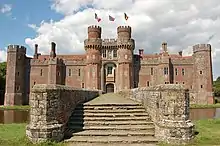Georgiana Hare-Naylor
Georgiana Hare-Naylor born Georgiana Shipley (circa 1755[1]–1806) was an English painter and art patron.
Georgiana Shipley | |
|---|---|
 | |
| Born | Georgiana Shipley 1755 |
| Died | 1806 |
| Nationality | British |
| Other names | Georgiana Hare-Naylor |
| Known for | painting and art patron |
| Spouse(s) | Francis Hare-Naylor |
| Children | four sons |
| Parent(s) | Bishop Shipley |
Life
Georgiana was born at St Asaph in 1752,[2] the fourth daughter of Anna Maria, born Mordaunt, and Jonathan Shipley, then a canon of Christ Church, Oxford and later Bishop of Llandaff and of St Asaph.[3] Her eldest sister Anna Maria married Sir William Jones, who proposed the existence of the Indo-European language.[4] Georgiana was a scholar, excellent at Latin.[2] She learned painting in Joshua Reynolds's studio and in 1781 exhibited at the Royal Academy in London.[5]
She was a few years older than her cousin and namesake Georgiana Spencer, later Georgiana Cavendish, Duchess of Devonshire. The duchess introduced her to Francis Hare-Naylor,[4] whom her father reluctantly invited to Twyford House.[6] The following day the young man was arrested for debt while driving in the Bishop's coach with Georgiana and her parents.[4]
The duchess settled an annuity of £200 on the young couple and with that they married, travelling first to Karlsruhe, and then to the north of Italy.[4][2] Georgiana devoted herself to painting and they settled in Bologna, where she formed a friendship with Clotilda Tambroni, Professor of Ancient Greek at the university there.[4] Georgiana was said to be fluent in Greek, which she taught her children.[6]
In 1792 she commissioned the artist and sculptor John Flaxman to create illustrations for Homer's books The Iliad and The Odyssey.[7] Flaxman's sister was the artist Maria Flaxman, governess to the Hare-Naylor children.[4]
In 1797 her father-in-law died and the Hare-Naylors set off for England, leaving three of their children in the care of Professor Tambroni and Father Emmanuele Aponte, a Spanish Jesuit priest. They appointed Giuseppe Caspar Mezzofanti as tutor to their eldest son.[4] This was thought an odd decision but Georgiana took her own counsel and her eldest attributed his love of learning to the time he spent with these scholars.[6]
The Hare-Naylors settled at Herstmonceux Castle. Her husband's principles made enemies, and he rejected a baronetcy. From 1799, when the Hare-Naylors sent for their children, life became a financial struggle, requiring support from the now-widowed Lady Jones.[4]

In 1803 Georgiana Hare-Naylor began a large series of pictures representing the Castle as it had appeared before the demolitions. She finished her work, but then lost her sight. In the following year the Hare-Naylors went to reside at Weimar, where the reigning duchess was on good terms with the family.[4] Georgiana was able to enjoy the company of leading scholars including Schiller and Goethe, but her health was failing.[6]
On Easter Sunday, 1806, Georgiana Hare-Naylor died at Lausanne,[8] leaving her children to the care of Lady Jones, her eldest sister. Her husband never returned to Hurstmonceaux, and in 1807 he sold the estate.[4]
There is a poignant memorial to her at Hurstmonceaux which shows her on her death bed entrusting her only daughter, Anna Maria Clemintina,[6] then about seven years old, to her sister. The work is credited to "a Danish artist, pupil of Thorwaldsen" (presumably Bertel Thorvaldsen, mainly known as a sculptor).
Family
Her four sons were Francis, Augustus, Julius, and Marcus, all born in Italy. Her only daughter, Anna Maria Clementina, was named after her elder sister.
References
- "Mrs Georgiana Hare-Naylor | Artist | Royal Academy of Arts". www.royalacademy.org.uk. Retrieved 4 July 2020.
- Jeffares, Neil (2006). Dictionary of Pastellists Before 1800. Unicorn Press. ISBN 978-0-906290-86-6.
- Chisholm, Hugh, ed. (1911). . Encyclopædia Britannica. 24 (11th ed.). Cambridge University Press. p. 982.
- Stephen, Leslie; Lee, Sidney, eds. (1890). . Dictionary of National Biography. 24. London: Smith, Elder & Co.
- "Mrs Georgiana Hare-Naylor | Artist | Royal Academy of Arts". www.royalacademy.org.uk. Retrieved 27 June 2020.
- Hare, Augustus J. C. (2011). Story of My Life, Volumes 1-3. Library of Alexandria. ISBN 978-1-4655-8197-6.
- "Collections Online | British Museum". www.britishmuseum.org. Retrieved 27 June 2020.
- Toit, Alexander Du (2004). "Naylor, Francis Hare- (1753–1815), historian". Oxford Dictionary of National Biography (online ed.). Oxford University Press. doi:10.1093/ref:odnb/12309. Retrieved 27 June 2020. (Subscription or UK public library membership required.)
- Attribution
![]() This article incorporates text from a publication now in the public domain: Stephen, Leslie; Lee, Sidney, eds. (1890). "Hare-Naylor, Francis". Dictionary of National Biography. 24. London: Smith, Elder & Co.
This article incorporates text from a publication now in the public domain: Stephen, Leslie; Lee, Sidney, eds. (1890). "Hare-Naylor, Francis". Dictionary of National Biography. 24. London: Smith, Elder & Co.
